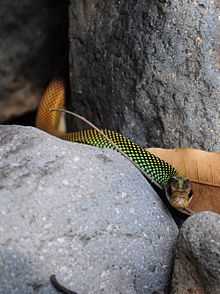Drymobius margaritiferus
| Drymobius margaritiferus | |
|---|---|
 | |
| Scientific classification | |
| Kingdom: | Animalia |
| Phylum: | Chordata |
| Subphylum: | Vertebrata |
| Class: | Reptilia |
| Order: | Squamata |
| Suborder: | Serpentes |
| Family: | Colubridae |
| Subfamily: | Colubrinae |
| Genus: | Drymobius |
| Species: | D. margaritiferus |
| Binomial name | |
| Drymobius margaritiferus (Schlegel, 1837) | |
| Synonyms | |
| |
Drymobius margaritiferus, commonly known as the speckled racer, is a species of nonvenomous colubrid snake native to the Americas. The specific name, margaritiferus, means "pearl-bearing" in Latin, referring to the pearl-like spots on the dorsal scales.
Geographic range
It is found from the Lower Rio Grande Valley of Texas in the United States[2] south to Colombia. As it is the northernmost ranging species of Drymobius, it is sometimes referred to as the northern speckled racer.
Description
The speckled racer is typically black in color with distinctive yellow and blue spotting, one light-colored spot on each scale,[3] which gives the snake an overall greenish hue. The labials are yellow, with black sutures.[1] The underside is typically yellow to green. They average 30-40 in. (76-102 cm) in length, record 50 in. (127 cm).[4]
The dorsal scales, which are feebly keeled middorsally, but smooth on the flanks, are arranged in 17 rows. The ventrals number 142-168; the subcaudals, 85-126.[5]
Behavior
Speckled racers are fast moving, nervous snakes[3] which do not often hesitate to bite if handled.
Habitat
They are typically found in densely vegetated habitats near permanent water sources.[4]
Diet
They will consume a wide variety of prey, but primarily feed on frogs and toads.[4]
Reproduction
They are oviparous, laying up to 8 eggs at any time in the spring or summer months.[6] The eggs incubate for approximately two months before hatching. Hatchlings are approximately 6 in (15 cm) in length and reach maturity in 2-3 years.
Subspecies
There are four recognized subspecies of D. margaritiferus:
- Drymobius margaritiferus margaritiferus (Schlegel, 1837)
- Drymobius margaritiferus fistulosus H.M. Smith, 1942
- Drymobius margaritiferus occidentalis Bocourt, 1890
- Drymobius margaritiferus maydis Villa, 1968[7]
Conservation status
The speckled racer is considered to be a threatened species in the US state of Texas.[8]
References
| Wikimedia Commons has media related to Drymobius margaritiferus. |
| Wikispecies has information related to: Drymobius margaritiferus |
- ↑ 1.0 1.1 Boulenger, G.A. (1894). Catalogue of the Snakes in the British Museum (Natural History). Volume II., Containing the Conclusion of the Colubridæ Aglyphæ. London: Trustees of the British Museum (Natural History). (Taylor and Francis, Printers.) xi + 328 pp. + Plates I.- XX. (Drymobius margaritiferus, pp. 17-18.).
- ↑ "Drymobius margaritiferus". Herps of Texas. University of Texas at Austin. Retrieved 2010-04-27.
- ↑ 3.0 3.1 Schmidt, K.P.; D.D. Davis (1941). Field Book of Snakes of the United States and Canada. New York: G.P. Putnam's Sons. 365 pp. (Drymobius margaritiferus, pp. 131-133, Figure 31.)
- ↑ 4.0 4.1 4.2 Conant, Roger (1975). A Field Guide to Reptiles and Amphibians of Eastern and Central North America. Second Edition. Boston: Houghton Mifflin. 429 pp. ISBN 0-395-19977-8 (paperback). (Drymobius margaritiferus, p. 186 + Plate 32 + Map 142.)
- ↑ Smith, H.M.; E.D. Brodie, Jr. (1982). Reptiles of North America: A Guide to Field Identification. New York: Golden Press. 240 pp. ISBN 0-307-13666-3 (paperback). (Drymobius margaritiferus, pp. 188-189.)
- ↑ Wright, A.H.; A.A. Wright (1957). Handbook of Snakes of the United States and Canada. Comstock. Ithaca and London. 1,105 pp. (in 2 volumes) (Drymobius margaritiferus, pp. 205-209, Figure 66., Map 22.)
- ↑ The Reptile Database. www.reptile-database.org.
- ↑ "Endangered Species". Texas Parks and Wildlife Department. Retrieved 2012-10-16.
Further reading
- Schlegel, H. (1837). Essai sur la physionomie des serpens. Amsterdam: M.H. Schonekat. Partie Générale. xxviii + 251 pp. (Herpetodryas margaritiferus, p. 151.) AND Partie Descriptive. 606 + xvi pp. (Herpetodryas margaritiferus, pp. 184-185.)
External links
- Species Drymobius margaritiferus at The Reptile Database